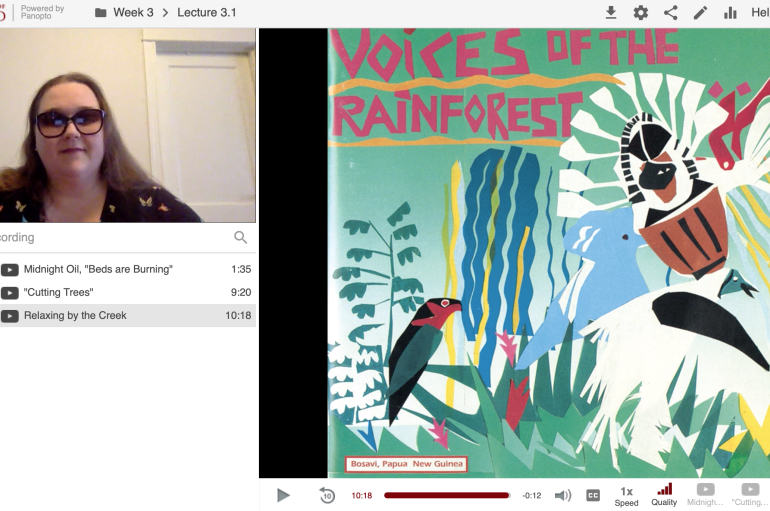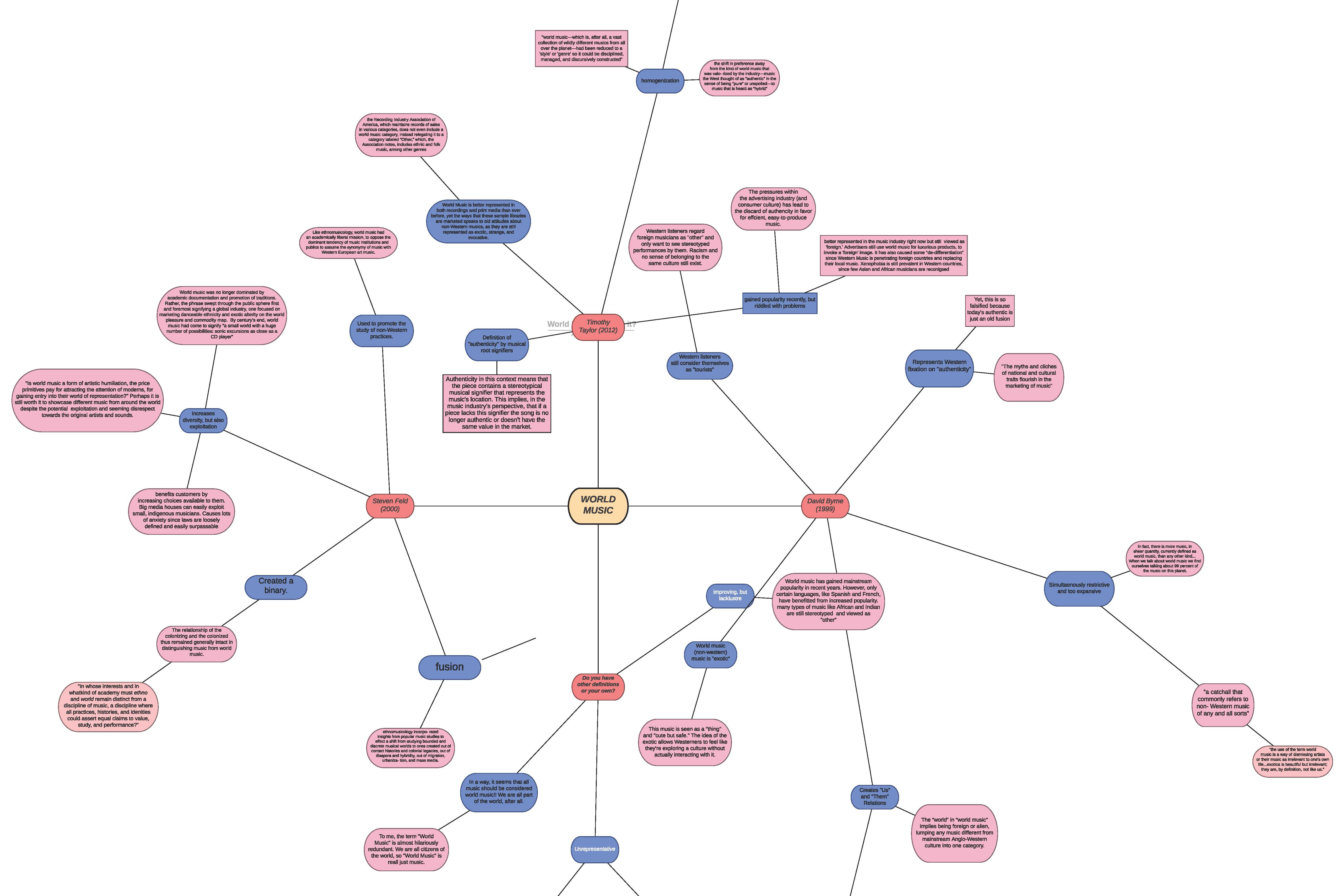
By Daniel Meyers
When the University of Chicago was one of the first U.S. universities to announce on March 12 that instruction in Spring 2020 would be moving online, the question on everyone’s mind was How do I move an entire course from the classroom to the computer?
For fifth year PhD candidate Ailsa Lipscombe, the task was even greater: How do I teach a course solo for the first time in an entirely new learning and instructional environment?
Lipscombe, an ethnomusicologist and music historian, had previously been a course assistant in three Music Department courses, but the Spring 2020 section of Music 10200: Intro to World Music would be her first time teaching any course alone. Six weeks later and in the third week of the quarter, it seems she’s found the recipe for success:
- Focus on your course objectives
- Develop inclusive pedagogy based on an understanding of students’ circumstances
- Be flexible
Starting from square one
Lipscombe had already created her syllabus for the spring quarter when she received the provost’s announcement on March 12. Given the news of the shift to remote learning, she sat down to re-write that syllabus. Four days later when the University announced it would be delaying the start of the Spring Quarter and shortening it by one week, she re-wrote it again.
“In each of those iterations, one thing I did was to really think about what the objectives are that I would like a student taking this class to achieve,” Lipscombe says. Rather than searching for a digital analogue for every aspect of the in-person class she had initially planned, she started with her objectives and worked backwards from there, finding “non-typical ways” to achieve those outcomes in a “non-typical scenario.”
It’s clear that this approach, even in a novel situation, is not new to Lipscombe. It’s one that mentors in the department, such as Professor Larry Zbikowski, who serves as the Director of Professional Development, have advocated for even before the reality of an extended global pandemic.
Following the advice of her mentors, Lipscombe distilled her objectives for her students to these three items:
- To talk and write about a diverse range of music using different descriptive and analytical languages and techniques
- To listen carefully, critically, and creatively to musics both familiar and unfamiliar
- And to critically research and consider music in light of its intersections with social, cultural, political, and economic dynamics
With those objectives at the front of her mind, Lipscombe began to re-envision her course and a path to those goals within a remote environment.
Embracing inclusive instruction
Lipscombe’s approach to course design in a triage scenario is clearly informed by her own experience. As a student and instructor with a disability, she recognizes the need to understand every student’s unique circumstances, whether physical, mental, or situational, and to design a course that is inclusive of everyone’s environment and capabilities.
“Classroom environments are often so alienating to students with disabilities,” Lipscombe explains. “This [situation] gave me an opportunity to reimagine what it would look like to create a classroom environment that is inclusive and responsive to those things that students with disabilities are always battling in a physical classroom.”
Before the start of the spring quarter, as many instructors did, Lipscombe surveyed her students, asking questions about their learning environments and internet and computer access, and revealing challenges of this situation – one where many students have been forced to return to homes spread across the country and around the world – that are unique still from a typical remote learning scenario.
Lipscombe’s students are studying now from five different time zones as far apart as China and Canada. Even those who are geographically close face obstacles to virtual participation; many are vying for time on a busy internet network with siblings and parents who are all learning and working from home, and a reliable high-speed cable connection is far from a given in many locales.
To overcome these obstacles, Lipscombe has stretched what would have been two 90-minute classes each week into two 24-hour instructional periods every Tuesday and Thursday. Rather than a dense, relatively short and sustained period of instruction, Lipscombe presents a “chain of tasks” each class day at 9 am. Students then have until 9 am the next day to complete the sequence on their own schedule.
The unique structure of Lipscombe’s digital class not only provides the necessary flexibility for students participating in a variety of circumstances from time zones across the world, it accommodates physical challenges that arise specifically in a remote learning environment, whether it is screen fatigue or inability to sit for long periods of time. Students are able to take breaks when they need them, and they can plan when they need access to the internet for a task and when they don’t.

The tasks that Lipscombe has created offer flexibility of a sort as well, engaging students in a variety of modes of learning each day. Typically, the chain begins with a 10- to 15-minute long recorded lecture that includes audio and visual examples and checks on comprehension. By pre-recording her lectures and allowing students to play, pause, rewind, and repeat as necessary, Lipscombe feels she is better able to approximate an in-person learning environment, where students are able to ask questions and request material to be repeated.
From there, the chain progresses with a variety of activities designed to engage students in a number of different ways. Discussion may be simulated by having students write a response to a reading, then reading other students’ responses and revising their own. Students may be prompted to practice collaborative free-thinking by collectively building out a mind-map with tools like Lucidchart. The classroom might be “flipped” by having students record 5-7 minute videos that respond to a listening and serve as a discussion prompt for the rest of the class.
By engaging students in a wide variety of activities, Lipscombe ensures that each student is learning in a way that is effective for them while also strengthening skills with which they are less adept. By requiring a variety of modes of participation while also offering flexibility, Lipscombe allows students to do more than just participate; she enables them to bring their whole selves to the class.
Being nimble
Flexibility has been key to Spring Quarter courses, both for enabling student participation and for providing the best possible instructional experience in a sub-optimal environment. It certainly hasn’t been a utopic experience – “I miss the energy of being in a classroom” says Lipscombe. “I miss the energy of being in that back and forth with my students, of leading the discussion and seeing it take off, and being able to use body language and the vibe of the room to determine how things are going.” But, she says, staying focused on her objectives has allowed her to spend less time being frustrated with the limitations on her and more time finding creative solutions.
Those solutions continue to evolve, too. With every student engagement, Lipscombe is able to evaluate what was successful and what wasn’t, and she adapts her solutions for the next class. She’s learned she can craft engagement by requiring students to revise their own work (such as a definition of “ethnomusicology”) after reviewing their peers’, and she can encourage student’s participation in an uncomfortable medium (creative writing) by allowing them to see their classmate’s submissions first. She’s seen that writing prompts that allow students to draw on their own experiences and opinions (and that are perhaps slightly controversial) spark more expansive discussions, and she knows that asking students to initial their responses is helpful to evaluate their participation and comprehension.
Lessons for the future
The lessons Lipscombe has learned teaching her first solo class will follow her into future courses, whether virtual or in-person. If she’s looking for a silver lining to this experience, it may be that she’s had the opportunity to familiarize herself and experiment with a variety of different digital tools, something she may not have otherwise had the chance to do.
Lipscombe’s instructional design may serve as a bit of a model for others, as well, particularly when it comes to matters of access. That’s one of the paradoxes of the current situation: disability rights advocates have fought for access to remote instruction and remote work for years as a way to accommodate differing abilities, but in a situation where remote environments have been adopted quickly and at times haphazardly, it is people with disabilities who have been most harmed.
As a person with a disability, Lipscombe is waiting to see what happens when quarantine restrictions are lifted. “Methods of remote learning have been asked for and sought after by disabled students and disabled workers for years and have consistently and emphatically been denied at every point. And now, suddenly, everyone is shifting to remote work, but the people most disadvantaged by those shifts are people with disabilities, because these technologies aren’t being adopted with an accessible mindset.”
While Lipscombe has faced many of the same challenges as others during a quick pivot to remote instruction, her approach to the problem offers a model of how to respond: understand everyone’s individual circumstances, offer a variety of ways to engage, and stay flexible while maintaining focus on your objectives. “I don’t think that there is a ubiquitous right or wrong way to do this, but I think that there is a right or wrong way to approach it.” She hopes that by embracing flexibility and inclusivity, and by centering the voices and experiences of people with disabilities, employers and academic institutions might better serve the needs of diverse student bodies and workforces even after stay-at-home orders are eased and in-person work and instruction resumes.
